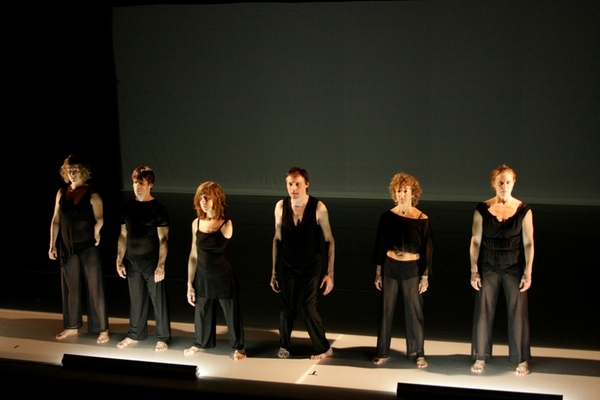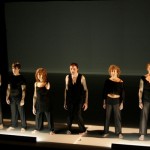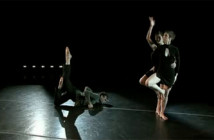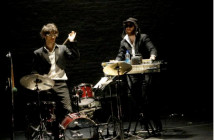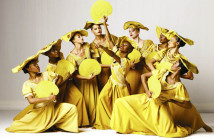GIMP @ THE INSTITUTE OF CONTEMPORARY ART
The prologue to the Friday, April 24th performance of “GIMP” at the ICA began outside on the museum’s gymnasium-sized wooden deck overlooking Boston Harbor. There the audience waited sipping wine, enjoying the warm weather, and looking curiously at a nineteen-foot high structure installed on the deck. The construction-site-like assembly consisted of four poles with a swatch of blood red fabric draped rope-like in the middle. As dusk fell and music began to play, the audience gathered closer to watch dancer Jennifer Bricker, a woman born without legs, and Nate Crawford, a veteran aerial performer, fold themselves into the fabric in such ways that either one or the other or both became air-born, swirling through the air with a cascade of red in their wake.
This incredibly sensuous opener--at one point Crawford, twisted in the red fabric, hovers above Bricker on the ground below him with their lips almost touching—was meant to embody the multiple meanings of the word “gimp,” which was also outlined on the program. From definition number one (“a ribbonlike, braided fabric”) to the third definition (“a lame person”), this piece from Alliger Arts and Heidi Latsky Dance sought to challenge and expand expectations of what dancers’ bodies should look like by using performers with disabilities. Though Latsky’s choreography relies on repetition to the point of excess and often moves against the music in nerve-grating ways, the extraordinary lighting design and solo performances give “GIMP” moments of beauty and wonder.
After the prologue, the audience moved inside the ICA’s theater where “GIMP” began with the dancers behind a scrim on which black, white and red images flashed. Highlighted in rectangles of soft yellow light, the shapes of the dancers’ bodies--one man’s legs bent inward, one woman was missing an arm—were cast in muted shadows until they began to move.
Throughout “GIMP,” the performers dance in multiple combinations: solos, duets, group, etc. During a duet to “I Like the Way (You Move),” one male dancer repeatedly stomped around two squares of light until his movements were no longer just predictable, but boring. When he was finally joined by another performer, it was a relief. The performance’s attempts to augment the audience’s perception of disabilities seemed to get lost in its affected approach. Later, the same stomping dancer taunted the audience, calling out, with a hint of sarcasm. that he thought we were all beautiful—as if he was predicting and ridiculing how viewers would discuss the performance amongst themselves later. His direct address was meant to unsettle; he wanted to make sure we were paying attention.
Overall, “GIMP” was most powerful when performers returned to the sensuality of the prologue. The moments where Latsky trusted her dancers and the audience enough to challenge them were the moments where the performance displayed the second definition of “gimp” as written in the program: “A fighting spirit; vigor.” One female performer in particular managed to display incredible energy and poise. At times she was called upon the swing her upper body up and down as if her hips were hinges. At other times she ran her different length arms over herself in such a way that it felt like the audience had stumbled in on her during a private moment in front of a mirror. Watching the shapes she could create with her unique body was both awe-inspiring and as provocative as Bricker’s opening performance.
Much of the choreography blurs together in “GIMP,” reducing the performers to shadows instead of displaying each person’s individuality or perhaps even their presence—during one song a female dancer repeatedly rolled around stage to the point where it was easy to forget she was even there.
- The GIMP ensemble. Photo by Luke Olson.
- A performance by GIMP aerialists. Photo by Chris Ash.
- The GIMP ensemble. Photo by Chris Ash.
The Institute of Contemporary Art, Boston
"GIMP" was performed at the ICA on Friday and Saturday, April 24 and 25, 2009
All images are courtesy of The Gimp Project and the ICA Boston.

